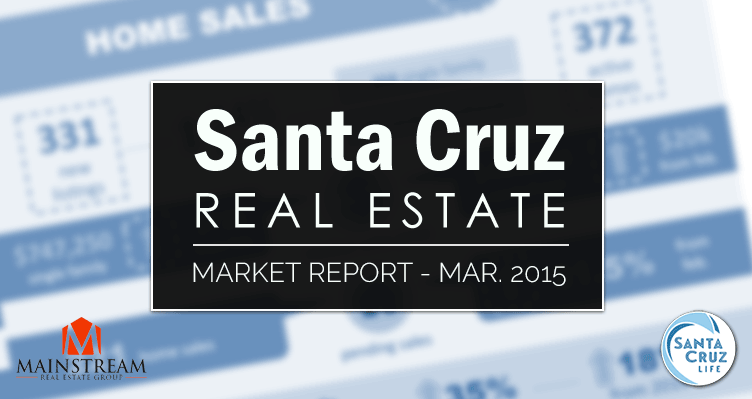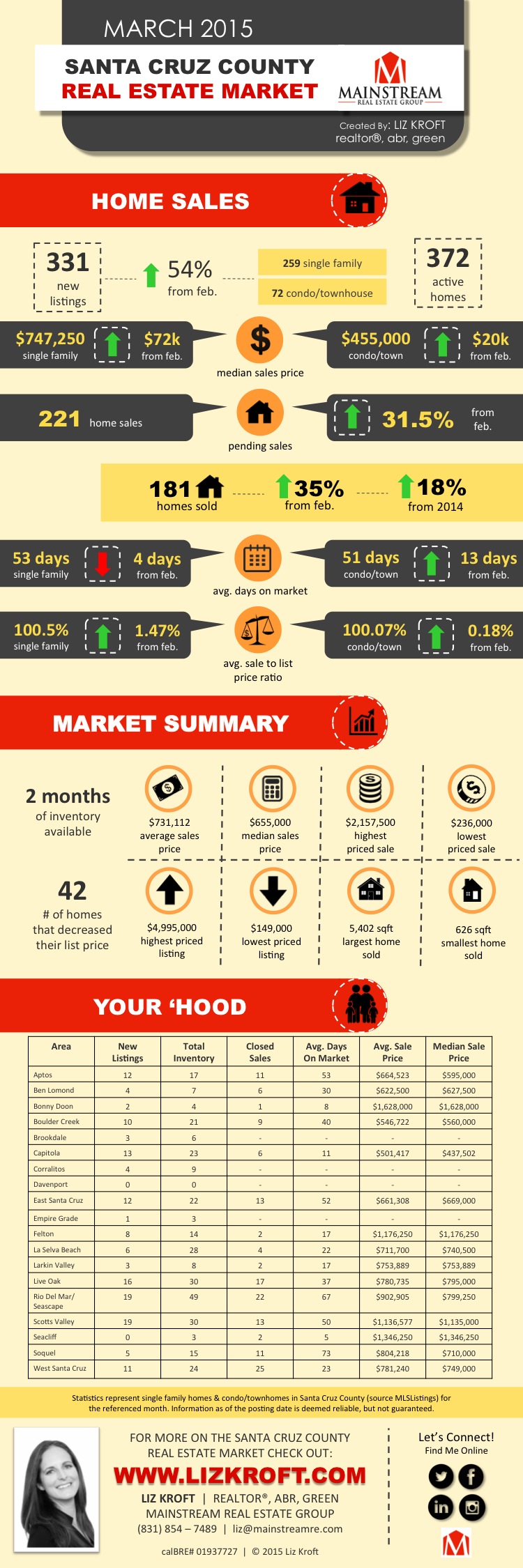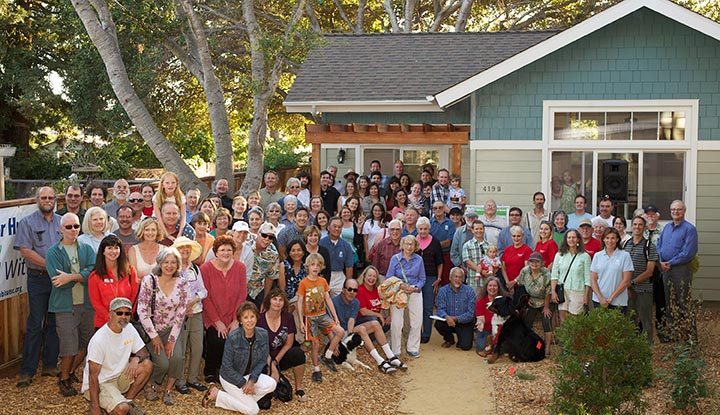
The following market report is provided by Liz Kroft & Lance Hulsey of Mainstream Real Estate Group.
Ask a few locals what the weather was like this morning and you’ll get wildly different answers depending on where each person lives within Santa Cruz County.
Your friend in Aptos may tell you it was foggy, someone in Seabright might gloat that it was warm and sunny, and yet another from Ben Lomond may tell you it was absolutely frigid.
We’re accustomed to microclimates, but there’s something similar which might not be as obvious:
Micro markets.
The “Santa Cruz Real Estate Market” is as nuanced as our local weather patterns. Each city and neighborhood has a unique housing market. This is important to keep in mind as we discuss the broader “Santa Cruz County” market.
Speaking of weather, and our local real estate market, rain isn’t the only thing we’re currently in short supply of.
At this point we all know that low housing inventory is also in short supply.
The supply of new homes is not keeping pace with the job and population growth that we’re seeing in Santa Cruz County. With historically low mortgage rates and other incentives, buyers are ready, yet sellers remain on the sidelines.
What gives?
More...

Factors Contributing to Low Inventory in Santa Cruz (and the Entire Bay Area)
A recent article in the San Francisco Chronicle cites a number of factors contributing to low inventory across the Bay Area. Some of these are:
- Fear of Buying: Homeowners are afraid to sell because they worry that they will not be able to afford a new home or find a new one before their original home sells.
- Foreclosures Nearly Gone: Foreclosures added substantially to inventory levels, especially of affordable homes. Foreclosure resales accounted for only 4.5% of Bay Area resales in early 2015 compared with a peak of 52% at the same time in 2009.
- Renting Not Selling: With sky-high rents in Santa Cruz and low interest rates, an increasing number of people who buy a new home are renting out their old one instead of selling.
- Taxes: A number of homeowners have delayed selling out of fear that they will be burdened with big capital gains tax1 bills. Not only are more homes subject to the tax, but the tax itself has risen.
- Proposition 132: A law passed in 1978 dissuades homeowners from selling because they might face a higher property tax bill. If they stay in their existing property their taxes cannot increase more than 2% per year.
The housing market will eventually recover its equilibrium between buyers and sellers – Market Equilibrium3 is Econ 101. The question though is not if it will happen but when. Two finalists from a local event in March called Cruz Cares, are trying to restore the balance. Before we cover the event, let’s look at what happened in Santa Cruz real estate in March.
Making Sense of the Numbers
At first glance, the numbers might not indicate it, but one thing is certain:
We’re in a seller’s market.
The 54% increase in new listings since February is somewhat misleading if taken out of context. This increase is coming from very low winter numbers. It would be like saying it’s 30 degrees warmer after coming from -20 in Antarctica into 10 degrees in Chicago – that’s still COLD!
Don’t let the increase in new homes for sale fool you, there are still far more buyers than sellers, and sellers continue to take advantage of tight home inventory and competition for homes.
This buyer competition resulted in a median sales price increase of $72K for Single Family Homes and $20K for Condos and Townhomes from February to March.
With this high buyer demand comes an increase in pending sales, a decrease in the time homes sit on the market, and, if you look at the year over year numbers for homes sold, you will see a pretty dramatic increase in the number of closed sales year over year and month over month.
We currently have 2 months of supply (this is calculated by dividing current inventory by the number of homes sold in the previous month). What this means is that given the current sales volume, it would only take two months to sell all of the current inventory. When this number is small, like it is now, it means that buyer demand is high, resulting in a seller’s market.
What the numbers tell us right now is that there are more buyers than sellers. Even with the overall increase in homes entering the market since February.
Check out the “Your ‘Hood” section of the infographic above to see if you can spot specific trends in your “micro market” neighborhood of interest compared to last month.
What the Numbers Don’t Tell You: Why March’s Market Was a Rollercoaster
For those of you who follow the Santa Cruz market, you may have noticed something strange in March with condominium/townhome inventory.
Active listings skyrocketed from 70 properties the week of March 2nd to 125 the week of the 9th and then plummeted back down to 64 the week of the 16th.
This drastic swing in active listings was not accompanied by a big change in pending or sold numbers.
So why the huge variation?
A lot happens behind the scenes that can throw market statistics off kilter (sometimes wildly so). In this instance, 48 additional properties in Watsonville were put on the market the same day by one agent. The properties were listed at $13 million each. $13 million was actually the value of all 48 properties together — you can see how this kind of error would drastically throw things off.
Take these anomalies in our area as an example:
There is a $19.5 million dollar home in Watsonville that has been on the market for 310 days. If we remove that from the data we analyze, why wouldn’t we remove the $7.9 million dollar home in Capitola that has been on the market for 380 days? And, while we’re at it, there is one on Bonny Doon Road listed for $6.8 million. That one is atypical and we should probably remove that, right?
And then what about … No. You have to keep it all.
What’s important to understand is that anomalies do impact these market report statistics, and that this data should be used as a starting point.

Cruz Cares Highlights the Need for More Affordable Housing
On March 4th at the Del Mar Theater, participants in an event called Cruz Cares: A Pitch for Social Change, joined the local real estate conversation.
Six local entrepreneurs were selected from a group of 42 total to present their pitch to a panel of judges in five minutes. They were judged on three criteria: potential for social impact, their financial plan and their ability to implement the plan.
Both 2nd and 3rd place went to housing related causes – 180/2020 and Habitat for Humanity, respectively.
- 180/2020 is working to end chronic homelessness in Santa Cruz County by 2020 through a permanent and assisted housing program. Founder Sibley Simon has proposed an innovative model to fund the program by leveraging deferred interest bonds and impact investing, eliminating the organizations reliance on public funds.
- Habitat for Humanity is developing a Senior Housing Partnership to empower low-income seniors by building Accessory Dwelling Units5 (ADUs) on their properties. This will provide a source of income for the seniors, help them downsize to a more manageable size home and allow them to stay in their neighborhood. Additionally, the Senior Housing Partnership will renovate the main house to increase its rental value.
Why did the judges vote in favor of two housing programs? The panel — comprised of nonprofits, angel investors, venture capitalists and startup founders — understands that there is a tremendous shortage of both market rate and affordable housing in Santa Cruz County.
Says Bud Colligan, one of the judges and a local social entrepreneur,
[Many] coastal communities in California share a similar problem caused by costly and burdensome permitting and planning department regulations, lack of water, a growing population who desires to live near the coast, and demand which far exceeds supply.
Founder & CEO, South Swell Ventures
Adds David Foster, Executive Director of Habitat for Humanity Santa Cruz,
Finding housing for lower-income residents is particularly difficult in the Santa Cruz area because our tourist oriented economy provides a large number of service sector jobs, but we have not done enough to provide housing for those workers. The results are overcrowded conditions or long commutes for our local employees.
Executive Director, Habitat for Humanity Santa Cruz
In other words, it is almost impossible to find newly constructed rental or ownership units on the open market that are affordable for households at or below the median income.
New affordable housing units are only being built when some form of assistance is available. The problem that we currently face, however, is that local, state, and federal housing dollars have been reduced by as much as 79% in California in the last three years. Housing Bond funds have been depleted and federal funds continue to decline year after year.
According to Foster,
Most devastating of all was the elimination of the Redevelopment Agencies that, by law, had to invest a minimum of 20% of their revenues into affordable housing programs -- close to $1.1 billion/year.
Executive Director, Habitat for Humanity Santa Cruz
Cities, counties, and the state still have a ways to go before they recover and have significant funds to again invest in affordable housing programs.
Fortunately, Santa Cruz Mayor, Don Lane, recognizes the enormity of the problem. In an article in the Santa Cruz Sentinel in February, Lane stressed that during his third time as mayor and his final term on the City Council, housing is a top priority in 2015.
How Habitat For Humanity Will Impact the Santa Cruz Rental Market
The judges at Cruz Cares were excited by the uniqueness and scalability encompassed by the 180/2020 and Habitat for Humanity proposals. According to Colligan, the two presenters “brought innovative concepts to a difficult problem: how to use creative financing techniques to build more affordable housing.”
180/2020’s plan to house the homeless could have a huge impact on many people’s lives. However, we are focusing on Habitat for Humanity’s proposal as it would directly impact the housing market for renters.
Habitat for Humanity, unlike most other affordable housing developers, builds fairly small-scale infill type projects. They rely on donations of local individuals and businesses and approximately 80% of the labor is provided by volunteers.
I like to think that Habitat [for Humanity], through its small-scale and volunteer programs, has brought the process of building affordable housing down to a level where the local community feels that they are part of the effort.
Executive Director, Habitat for Humanity Santa Cruz
So how will ADUs (accessible dwelling units) for seniors, Habitat for Humanity’s winning proposal, create more affordable housing?
Most cities now recognize that there is a growing housing problem facing the senior population. AARP estimates that the number of seniors will double in the next 25 years.
The 2010 census found that Santa Cruz City’s senior population includes nearly 300 low-income senior homeowners who are paying more than 50% of their income for housing and that many of them are at risk of losing their homes. Those numbers may only continue to grow.
Habitat for Humanity is proposing a program that would work with low-income senior homeowners to help them downsize into a sustainable and ADA compliant ADU built in the backyard of their existing home. The main house would then be renovated as needed and rented out as a way to pay for the cost of the new construction and to help stabilize household income. By opening up the main house to renters, this program will serve both senior homeowners and the rental market.
The City of Santa Cruz has been a national leader in the movement to allow the construction of ADUs in single-family neighborhoods, according to Foster. Since 2003 the City has approved the development of over 240 of these units.
Below are photos from an ADU on Harbor Drive which was built by Habitat for Humanity last spring.
LAPP Update
In last month’s market report we touched on the Legalization Assistance Permit Program (LAPP). This is in essence a “get out of jail free” (or cheaper) card for cost-effectively legalizing unpermitted construction with no “gotcha” from the Planning Department. In mid-March Liz attended a seminar at the Santa Cruz County Association of Realtors where two Planning Department officials provided an in depth discussion of LAPP. Her blog post outlines the details of the program and the message that the city hopes to convey.
A special thanks to Bud Colligan and David Foster for taking the time to contribute their knowledge and perspective to this piece.
At Mainstream Real Estate Group education is a BIG part of our culture, not just for ourselves but for our clients, our friends and our families. Each month we will help define real estate terms. Did we miss something? We want to know what you want to know!
Capital Gains Tax
Proposition 13
Market Equilibrium
MLS
Accessory Dwelling Unit (ADU)
Ask Liz & Lance
Have a real estate question? Let us know what's on your mind!







